Alcohol and Substance Abuse: Pathophysiology, Signs and Symptoms, Treatment and Aboriginal Factors
VerifiedAdded on 2023/06/15
|22
|1441
|245
AI Summary
This presentation discusses the pathophysiology, signs and symptoms, treatment and Aboriginal factors of alcohol and substance abuse. It covers the history of drug abuse among the Aboriginals and the factors that contribute to drug abuse. The presentation also explores the treatment methods used by the Aboriginal people.
Contribute Materials
Your contribution can guide someone’s learning journey. Share your
documents today.

UNIT:
NAME:
DATE:
NAME:
DATE:
Secure Best Marks with AI Grader
Need help grading? Try our AI Grader for instant feedback on your assignments.
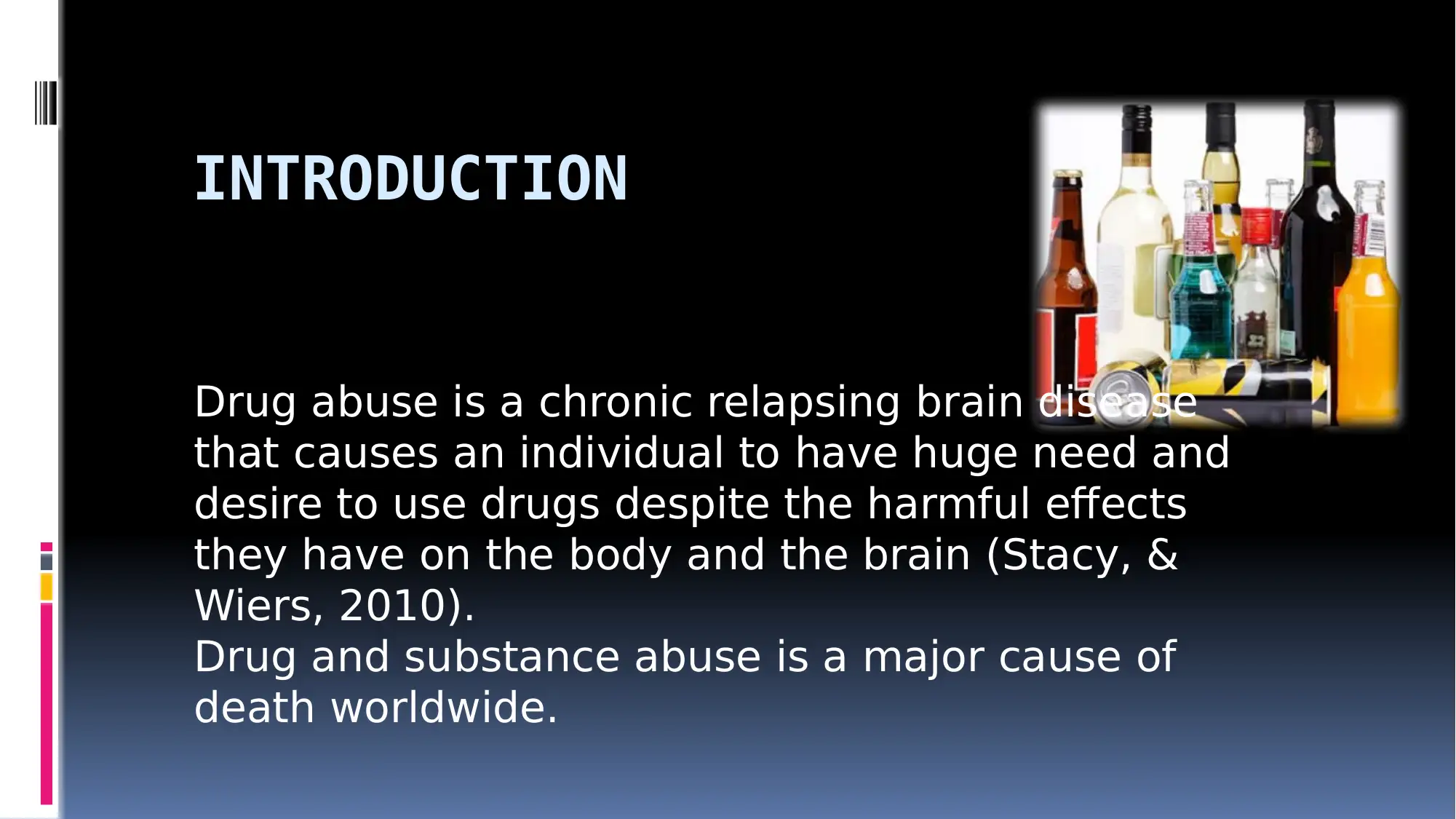
INTRODUCTION
Drug abuse is a chronic relapsing brain disease
that causes an individual to have huge need and
desire to use drugs despite the harmful effects
they have on the body and the brain (Stacy, &
Wiers, 2010).
Drug and substance abuse is a major cause of
death worldwide.
Drug abuse is a chronic relapsing brain disease
that causes an individual to have huge need and
desire to use drugs despite the harmful effects
they have on the body and the brain (Stacy, &
Wiers, 2010).
Drug and substance abuse is a major cause of
death worldwide.
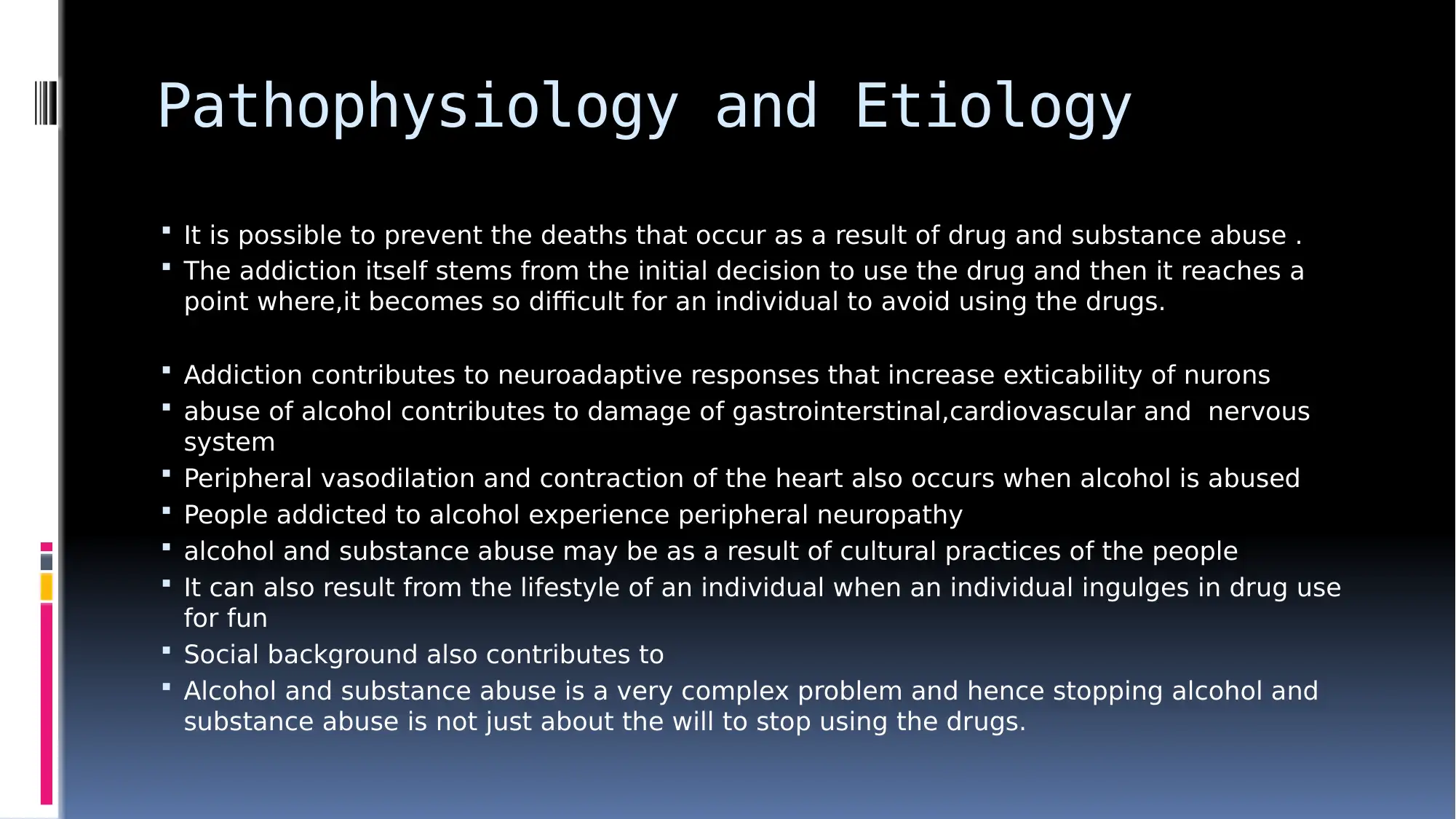
Pathophysiology and Etiology
It is possible to prevent the deaths that occur as a result of drug and substance abuse .
The addiction itself stems from the initial decision to use the drug and then it reaches a
point where,it becomes so difficult for an individual to avoid using the drugs.
Addiction contributes to neuroadaptive responses that increase exticability of nurons
abuse of alcohol contributes to damage of gastrointerstinal,cardiovascular and nervous
system
Peripheral vasodilation and contraction of the heart also occurs when alcohol is abused
People addicted to alcohol experience peripheral neuropathy
alcohol and substance abuse may be as a result of cultural practices of the people
It can also result from the lifestyle of an individual when an individual ingulges in drug use
for fun
Social background also contributes to
Alcohol and substance abuse is a very complex problem and hence stopping alcohol and
substance abuse is not just about the will to stop using the drugs.
It is possible to prevent the deaths that occur as a result of drug and substance abuse .
The addiction itself stems from the initial decision to use the drug and then it reaches a
point where,it becomes so difficult for an individual to avoid using the drugs.
Addiction contributes to neuroadaptive responses that increase exticability of nurons
abuse of alcohol contributes to damage of gastrointerstinal,cardiovascular and nervous
system
Peripheral vasodilation and contraction of the heart also occurs when alcohol is abused
People addicted to alcohol experience peripheral neuropathy
alcohol and substance abuse may be as a result of cultural practices of the people
It can also result from the lifestyle of an individual when an individual ingulges in drug use
for fun
Social background also contributes to
Alcohol and substance abuse is a very complex problem and hence stopping alcohol and
substance abuse is not just about the will to stop using the drugs.
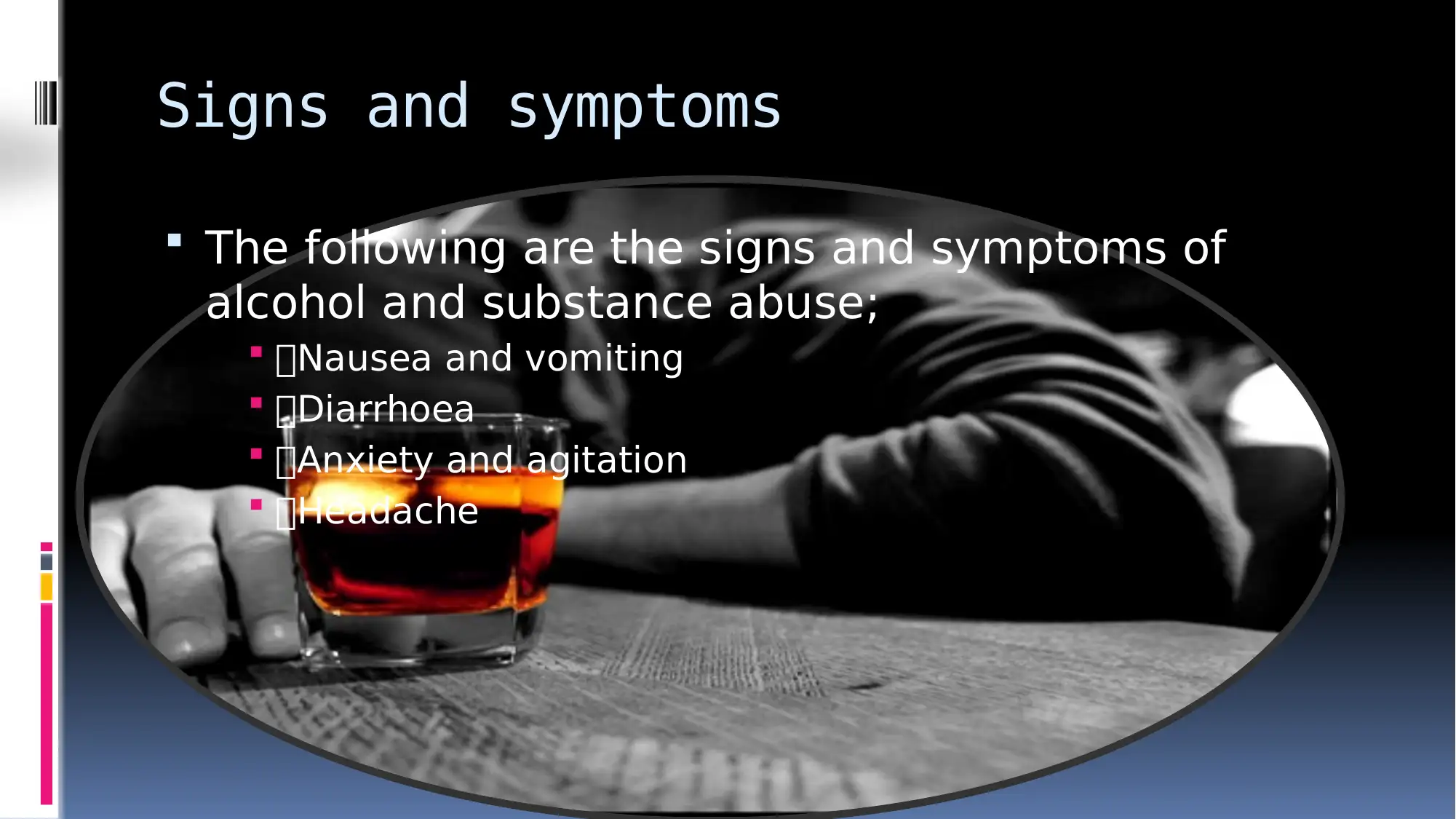
Signs and symptoms
The following are the signs and symptoms of
alcohol and substance abuse;
Nausea and vomiting
Diarrhoea
Anxiety and agitation
Headache
The following are the signs and symptoms of
alcohol and substance abuse;
Nausea and vomiting
Diarrhoea
Anxiety and agitation
Headache
Secure Best Marks with AI Grader
Need help grading? Try our AI Grader for instant feedback on your assignments.
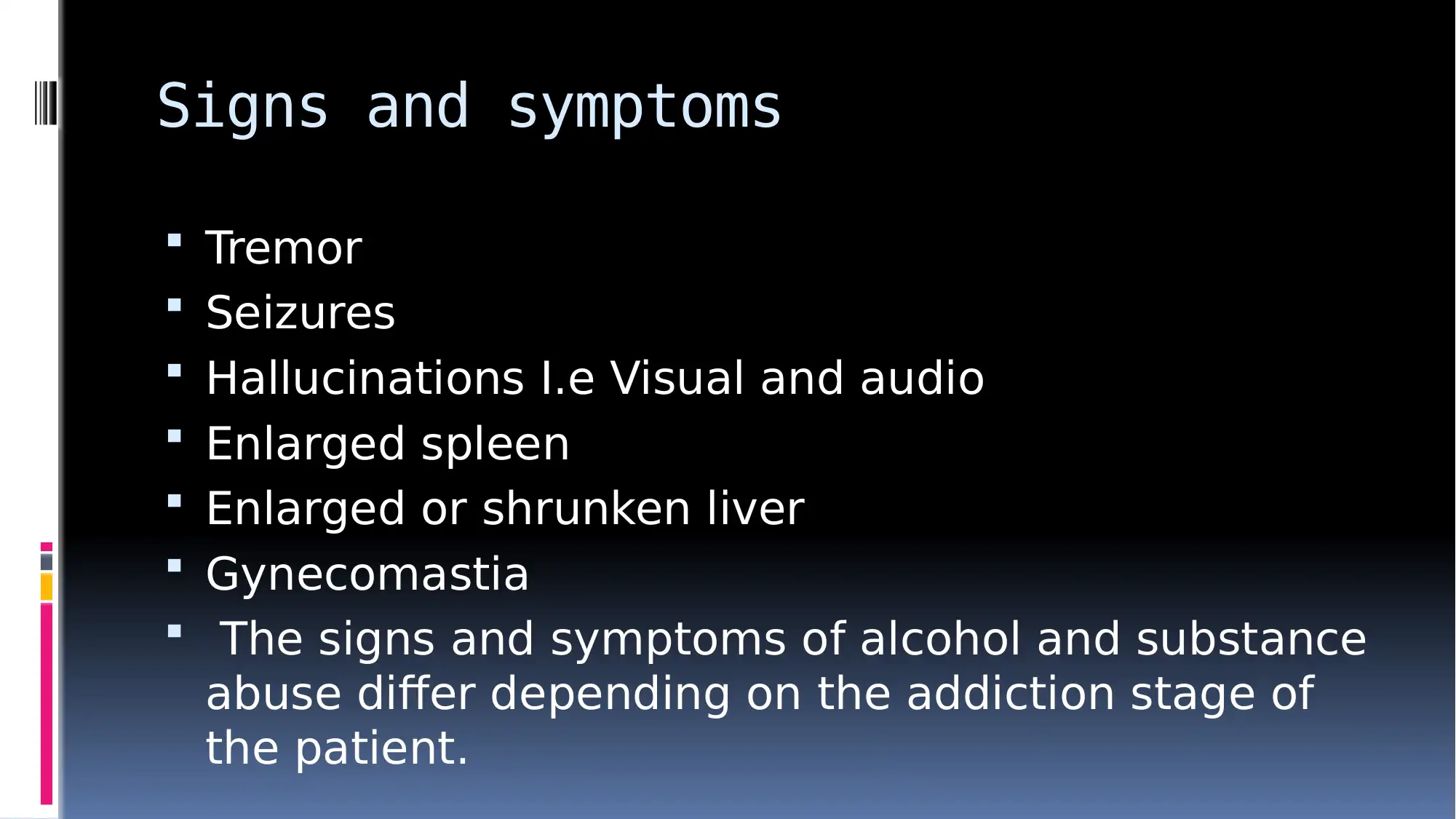
Signs and symptoms
Tremor
Seizures
Hallucinations I.e Visual and audio
Enlarged spleen
Enlarged or shrunken liver
Gynecomastia
The signs and symptoms of alcohol and substance
abuse differ depending on the addiction stage of
the patient.
Tremor
Seizures
Hallucinations I.e Visual and audio
Enlarged spleen
Enlarged or shrunken liver
Gynecomastia
The signs and symptoms of alcohol and substance
abuse differ depending on the addiction stage of
the patient.

Prognosis
Addiction is a very serious problem that can lead
to both mental and physical health complications.
Continued use of alcohol and drugs leads to
illnesses such as liver cancer,throat cancer and
diabetes.
Addiction results to social problems since it also
affects the families and other people who are close
to the person who is addicted to drugs.
It may lead to death if not treated promptly.
Addiction is a very serious problem that can lead
to both mental and physical health complications.
Continued use of alcohol and drugs leads to
illnesses such as liver cancer,throat cancer and
diabetes.
Addiction results to social problems since it also
affects the families and other people who are close
to the person who is addicted to drugs.
It may lead to death if not treated promptly.

Treatment
Treatment of alcohol and substance abuse is done
through both pharmacological and non-
pharmacological methods.
One of the methods is administration of drugs by
a doctor to help reduce the effects of withdrawing
from the use of alcohol and other drugs.
Behavioral therapy
physical therapy
rehabilation
Treatment of alcohol and substance abuse is done
through both pharmacological and non-
pharmacological methods.
One of the methods is administration of drugs by
a doctor to help reduce the effects of withdrawing
from the use of alcohol and other drugs.
Behavioral therapy
physical therapy
rehabilation
Paraphrase This Document
Need a fresh take? Get an instant paraphrase of this document with our AI Paraphraser

Statistics of drug use in Canada
The statistics on alcohol and substance abuse in
Canada are provided by the Canadian Alcohol and
Drug Use Monitoring Survey (CADUMS).
The survey is carried out among people aged
above 15 years.
The statistics collected in the year 2016 indicates
that about 17% of Canadians aged above 15 years
use one or more type of drugs (Jacobus, & Tapert,
2013).
The statistics on alcohol and substance abuse in
Canada are provided by the Canadian Alcohol and
Drug Use Monitoring Survey (CADUMS).
The survey is carried out among people aged
above 15 years.
The statistics collected in the year 2016 indicates
that about 17% of Canadians aged above 15 years
use one or more type of drugs (Jacobus, & Tapert,
2013).
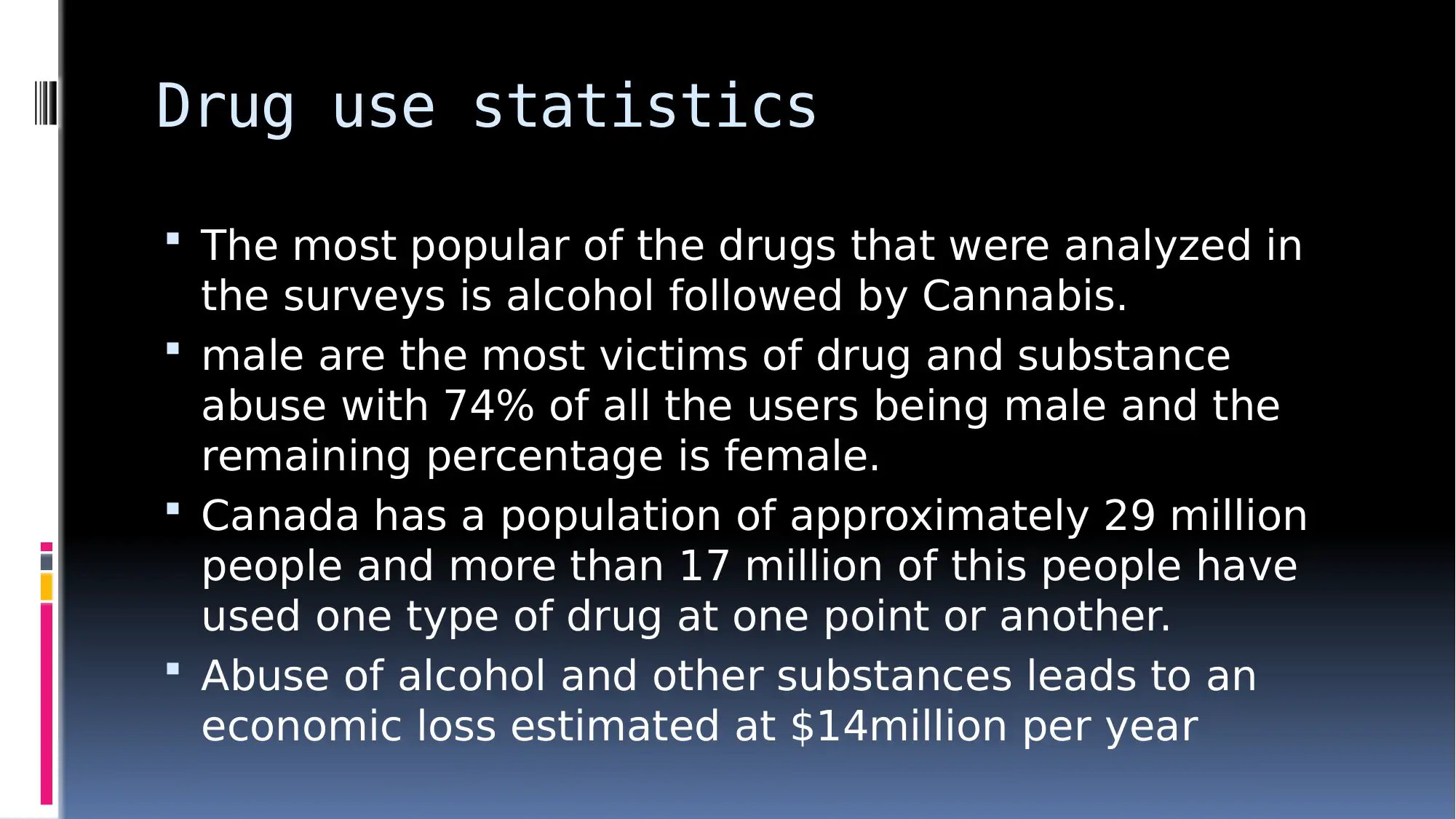
Drug use statistics
The most popular of the drugs that were analyzed in
the surveys is alcohol followed by Cannabis.
male are the most victims of drug and substance
abuse with 74% of all the users being male and the
remaining percentage is female.
Canada has a population of approximately 29 million
people and more than 17 million of this people have
used one type of drug at one point or another.
Abuse of alcohol and other substances leads to an
economic loss estimated at $14million per year
The most popular of the drugs that were analyzed in
the surveys is alcohol followed by Cannabis.
male are the most victims of drug and substance
abuse with 74% of all the users being male and the
remaining percentage is female.
Canada has a population of approximately 29 million
people and more than 17 million of this people have
used one type of drug at one point or another.
Abuse of alcohol and other substances leads to an
economic loss estimated at $14million per year
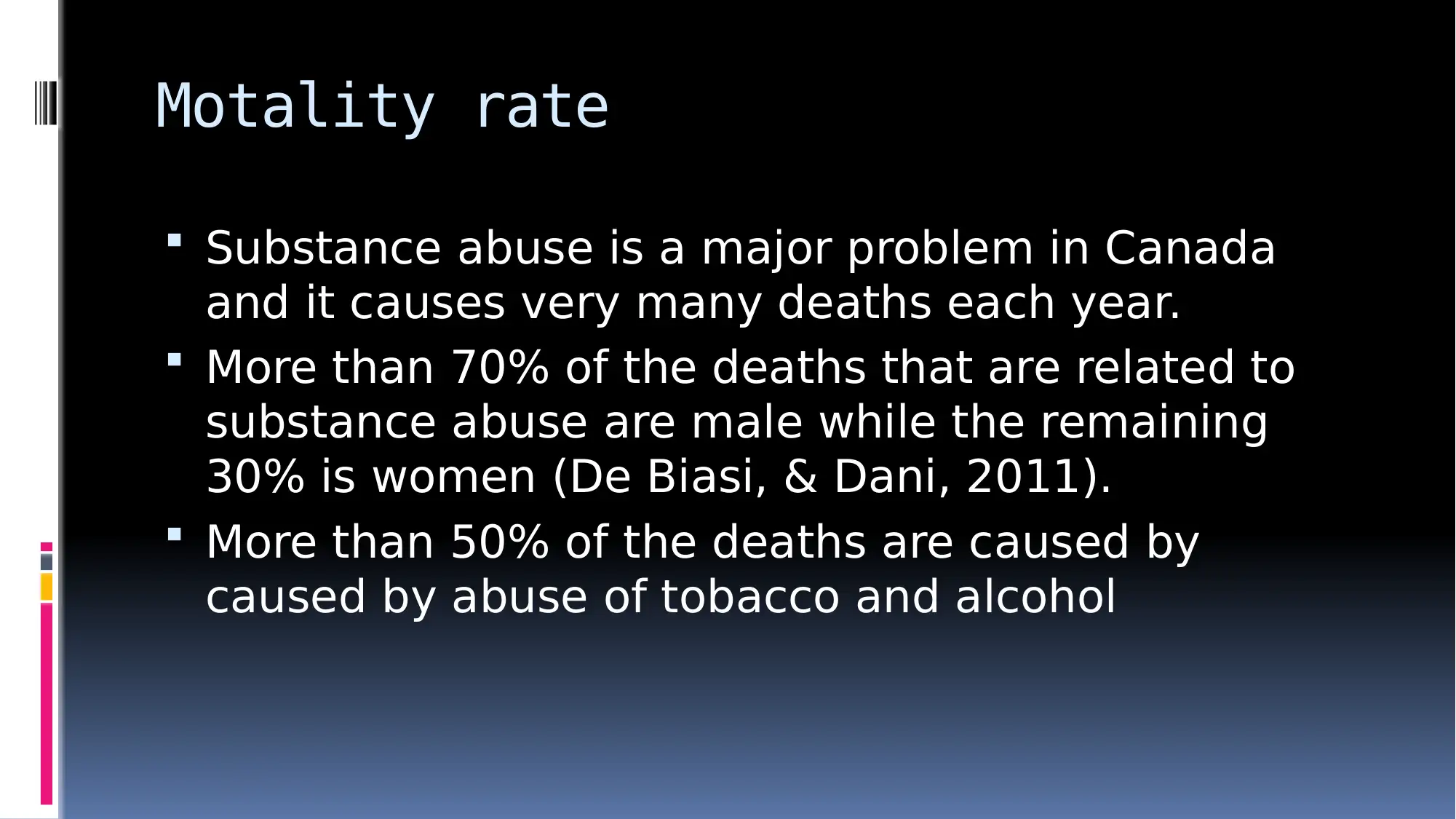
Motality rate
Substance abuse is a major problem in Canada
and it causes very many deaths each year.
More than 70% of the deaths that are related to
substance abuse are male while the remaining
30% is women (De Biasi, & Dani, 2011).
More than 50% of the deaths are caused by
caused by abuse of tobacco and alcohol
Substance abuse is a major problem in Canada
and it causes very many deaths each year.
More than 70% of the deaths that are related to
substance abuse are male while the remaining
30% is women (De Biasi, & Dani, 2011).
More than 50% of the deaths are caused by
caused by abuse of tobacco and alcohol
Secure Best Marks with AI Grader
Need help grading? Try our AI Grader for instant feedback on your assignments.
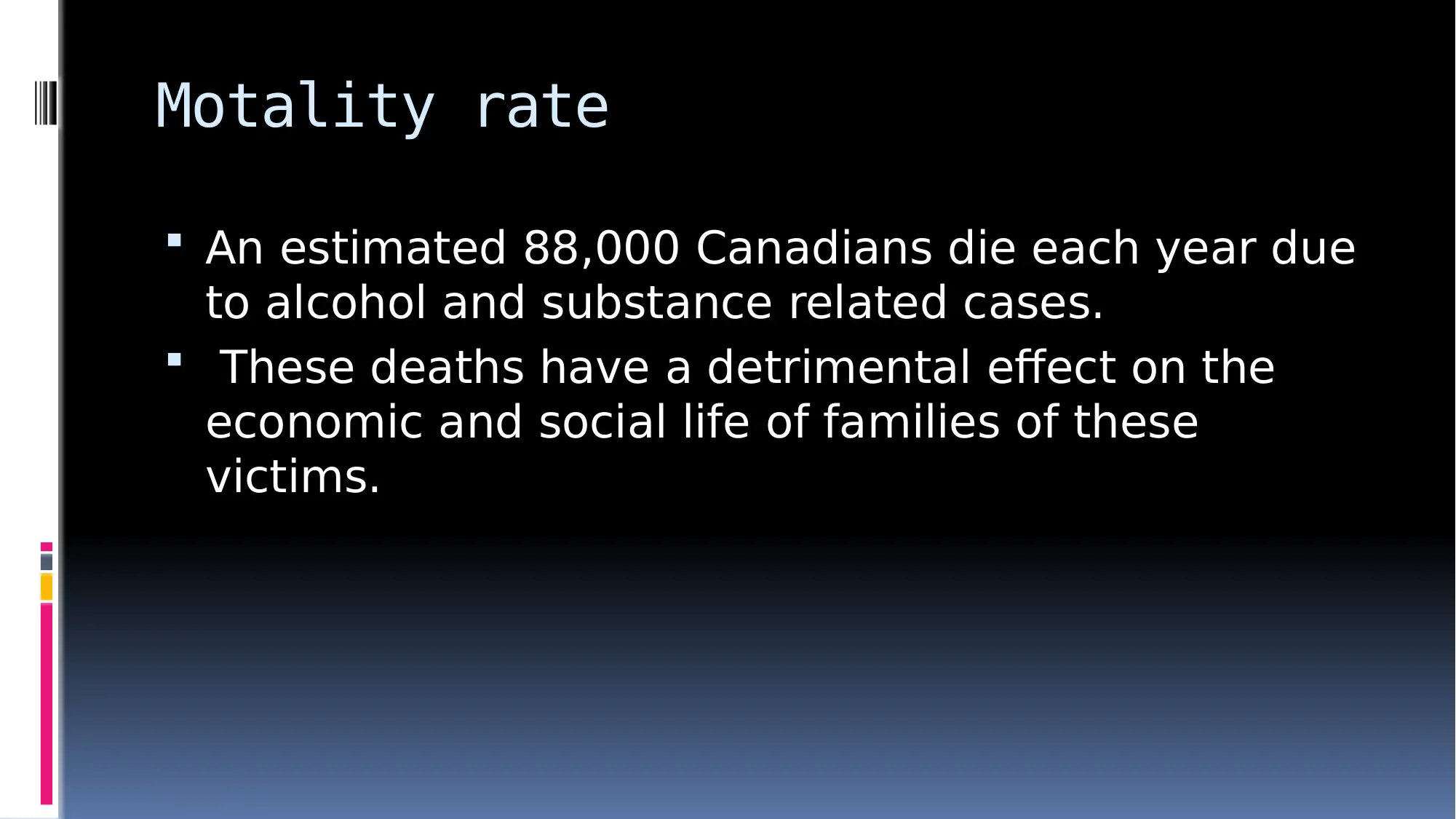
Motality rate
An estimated 88,000 Canadians die each year due
to alcohol and substance related cases.
These deaths have a detrimental effect on the
economic and social life of families of these
victims.
An estimated 88,000 Canadians die each year due
to alcohol and substance related cases.
These deaths have a detrimental effect on the
economic and social life of families of these
victims.
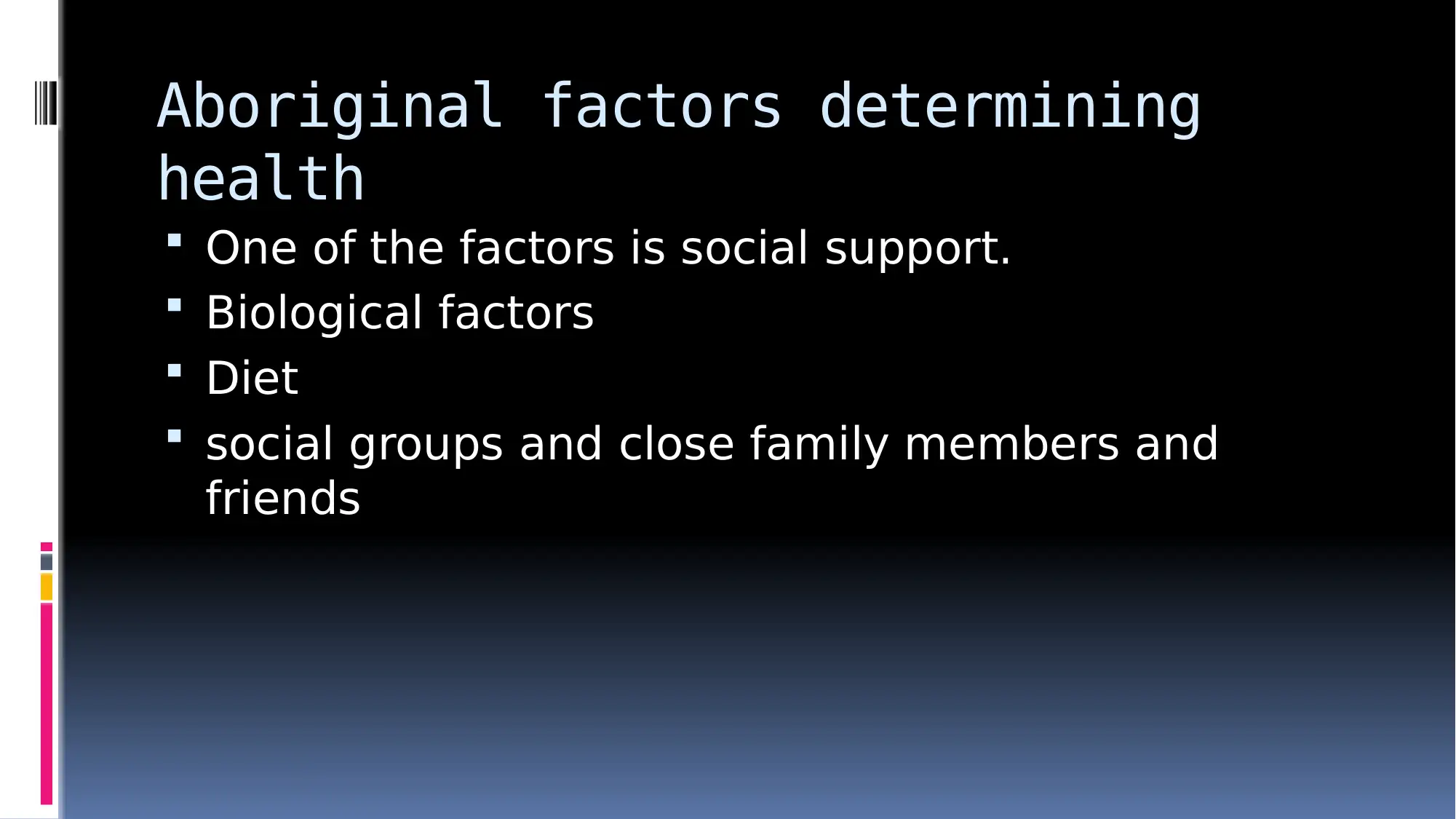
Aboriginal factors determining
health
One of the factors is social support.
Biological factors
Diet
social groups and close family members and
friends
health
One of the factors is social support.
Biological factors
Diet
social groups and close family members and
friends
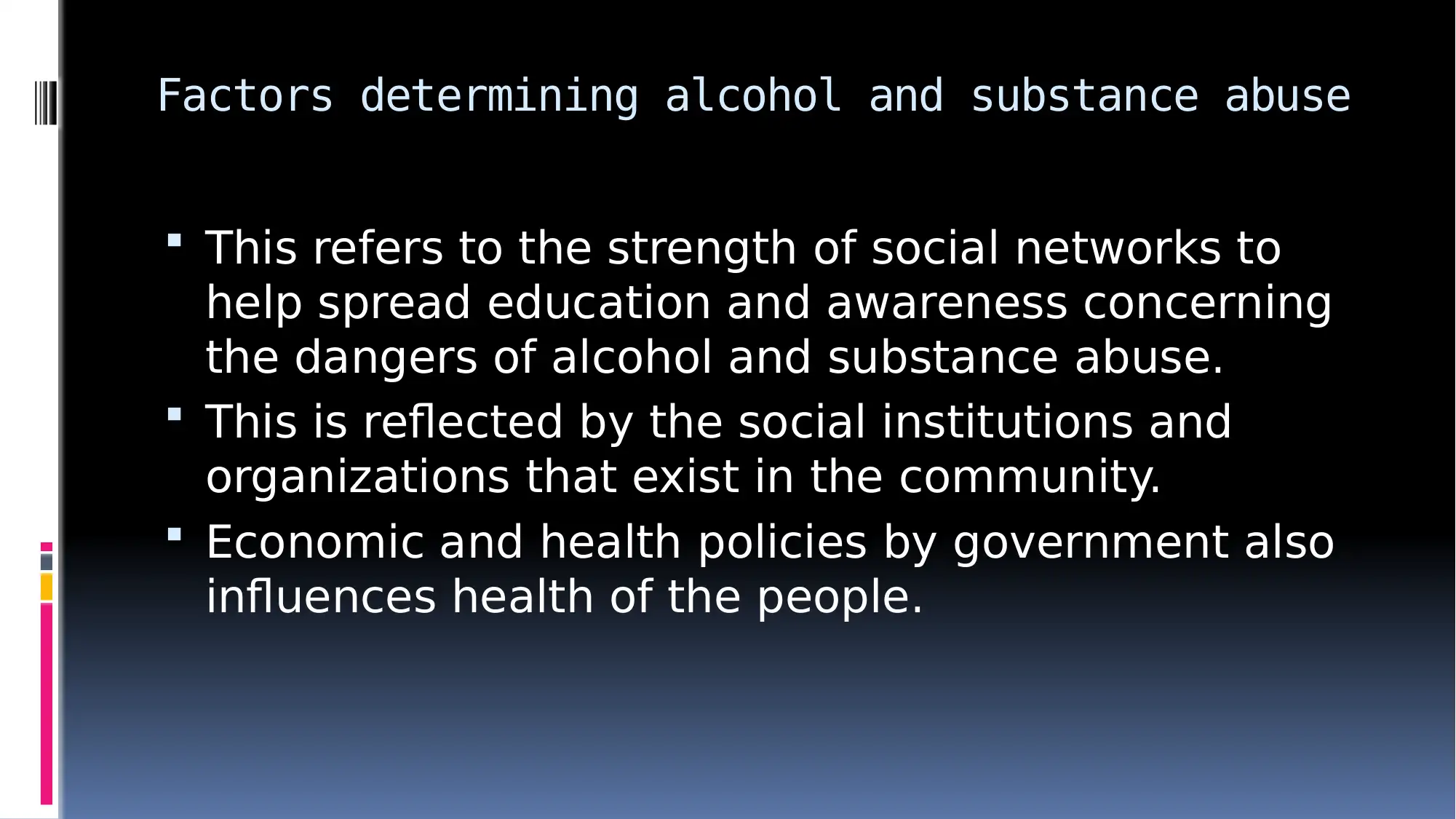
Factors determining alcohol and substance abuse
This refers to the strength of social networks to
help spread education and awareness concerning
the dangers of alcohol and substance abuse.
This is reflected by the social institutions and
organizations that exist in the community.
Economic and health policies by government also
influences health of the people.
This refers to the strength of social networks to
help spread education and awareness concerning
the dangers of alcohol and substance abuse.
This is reflected by the social institutions and
organizations that exist in the community.
Economic and health policies by government also
influences health of the people.
Paraphrase This Document
Need a fresh take? Get an instant paraphrase of this document with our AI Paraphraser

Personal health
Another factor is personal health practices
and coping skill.
The social life of an individual plays an
important role in determing the health of a
person
The level of income of an individual and
their economic standards influences health
Another factor is personal health practices
and coping skill.
The social life of an individual plays an
important role in determing the health of a
person
The level of income of an individual and
their economic standards influences health

History of alcohol and substance abuse among the
aboriginal
Alcohol and substance abuse among the aboriginal
has a long history.
The high rate of alcohol and substance abuse
among the aboriginal can mainly be attributed to
generational cultural practices.
The problem began many years ago and became
inherited by the descendant of this people and it
has become a huge problem at this point
aboriginal
Alcohol and substance abuse among the aboriginal
has a long history.
The high rate of alcohol and substance abuse
among the aboriginal can mainly be attributed to
generational cultural practices.
The problem began many years ago and became
inherited by the descendant of this people and it
has become a huge problem at this point
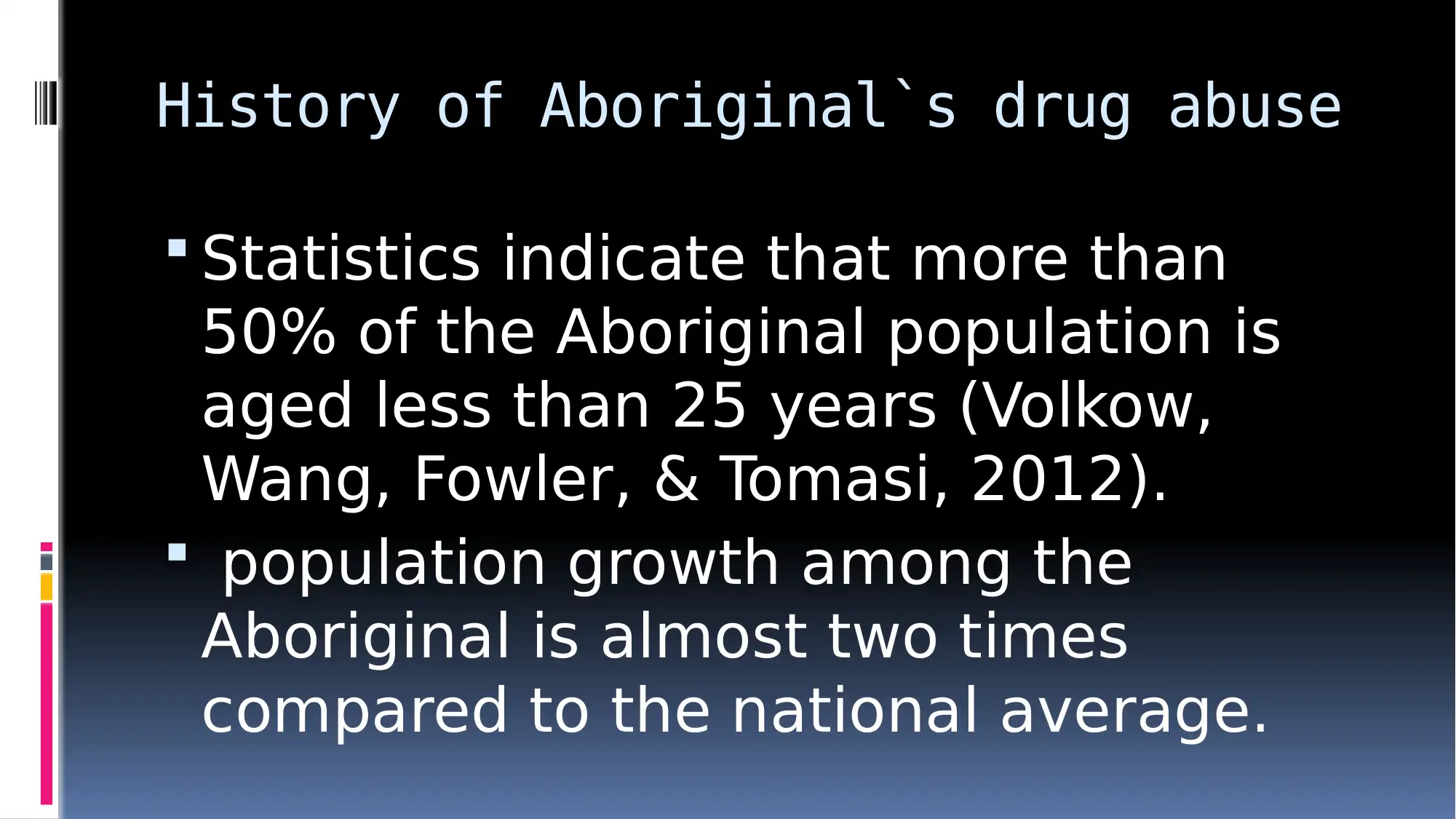
History of Aboriginal`s drug abuse
Statistics indicate that more than
50% of the Aboriginal population is
aged less than 25 years (Volkow,
Wang, Fowler, & Tomasi, 2012).
population growth among the
Aboriginal is almost two times
compared to the national average.
Statistics indicate that more than
50% of the Aboriginal population is
aged less than 25 years (Volkow,
Wang, Fowler, & Tomasi, 2012).
population growth among the
Aboriginal is almost two times
compared to the national average.
Secure Best Marks with AI Grader
Need help grading? Try our AI Grader for instant feedback on your assignments.

Factors that contributes to abuse of drugs among the
Aboriginals
Historically,a factor that has resulted to the
alcohol and substance abuse among the Aboriginal
is poverty.
Poverty results to people resulting to alcohol and
substance abuse because
People use drugs to relieve stress and
momentarily forget their problems.
Lack of proper education and awareness on
dangers of using drugs
Aboriginals
Historically,a factor that has resulted to the
alcohol and substance abuse among the Aboriginal
is poverty.
Poverty results to people resulting to alcohol and
substance abuse because
People use drugs to relieve stress and
momentarily forget their problems.
Lack of proper education and awareness on
dangers of using drugs
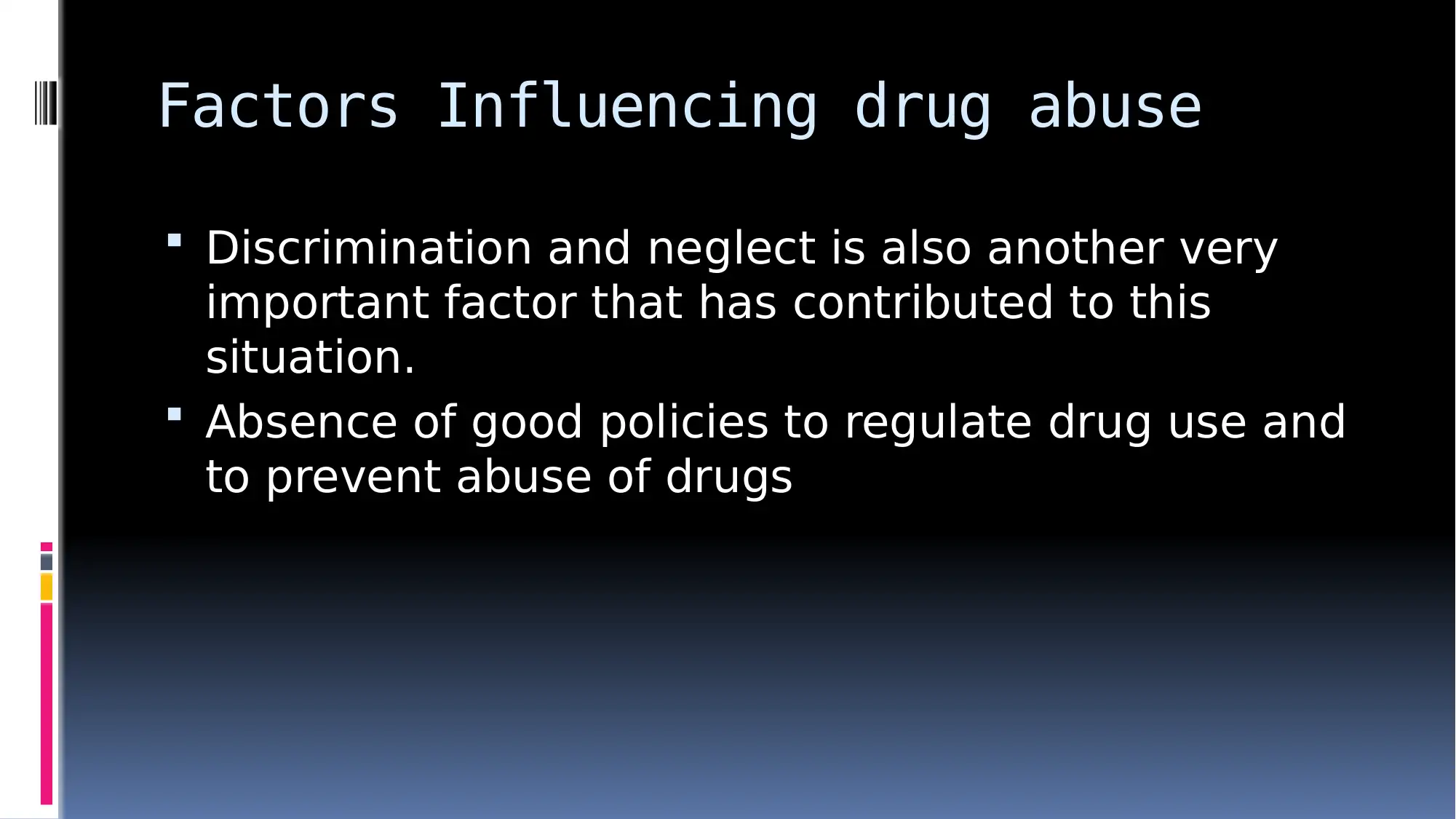
Factors Influencing drug abuse
Discrimination and neglect is also another very
important factor that has contributed to this
situation.
Absence of good policies to regulate drug use and
to prevent abuse of drugs
Discrimination and neglect is also another very
important factor that has contributed to this
situation.
Absence of good policies to regulate drug use and
to prevent abuse of drugs

Treatment methods
The Aboriginal people ways of treating alcohol and
substance abuse is based on the culture and
traditional beliefs and practices (Bramness,
Henriksen, Person, & Mann, 2014).
The people also use biological methods to treat
substance and alcohol abuse.
The Aboriginal people ways of treating alcohol and
substance abuse is based on the culture and
traditional beliefs and practices (Bramness,
Henriksen, Person, & Mann, 2014).
The people also use biological methods to treat
substance and alcohol abuse.
Paraphrase This Document
Need a fresh take? Get an instant paraphrase of this document with our AI Paraphraser

Treatment
Traditional healers and medicine men among the
Aboriginal perceive alcohol as an evil spirit that
has destroyed the ways of life of the people.
They therefore belief that the fight against drug
abuse is spiritual war and therefore it should be
treated spiritually.
Traditional healers and medicine men among the
Aboriginal perceive alcohol as an evil spirit that
has destroyed the ways of life of the people.
They therefore belief that the fight against drug
abuse is spiritual war and therefore it should be
treated spiritually.

Seat Lodge and modern methods
The Aboriginal also conduct Sweat Lodge
ceremonies to purify the bodies of people who are
addicted to alcohol and substance abuse.
The people of Aboriginal also combine the
traditional healing methods with modern methods
for example by using behavioral therapy and
medicines.
The Aboriginal also conduct Sweat Lodge
ceremonies to purify the bodies of people who are
addicted to alcohol and substance abuse.
The people of Aboriginal also combine the
traditional healing methods with modern methods
for example by using behavioral therapy and
medicines.
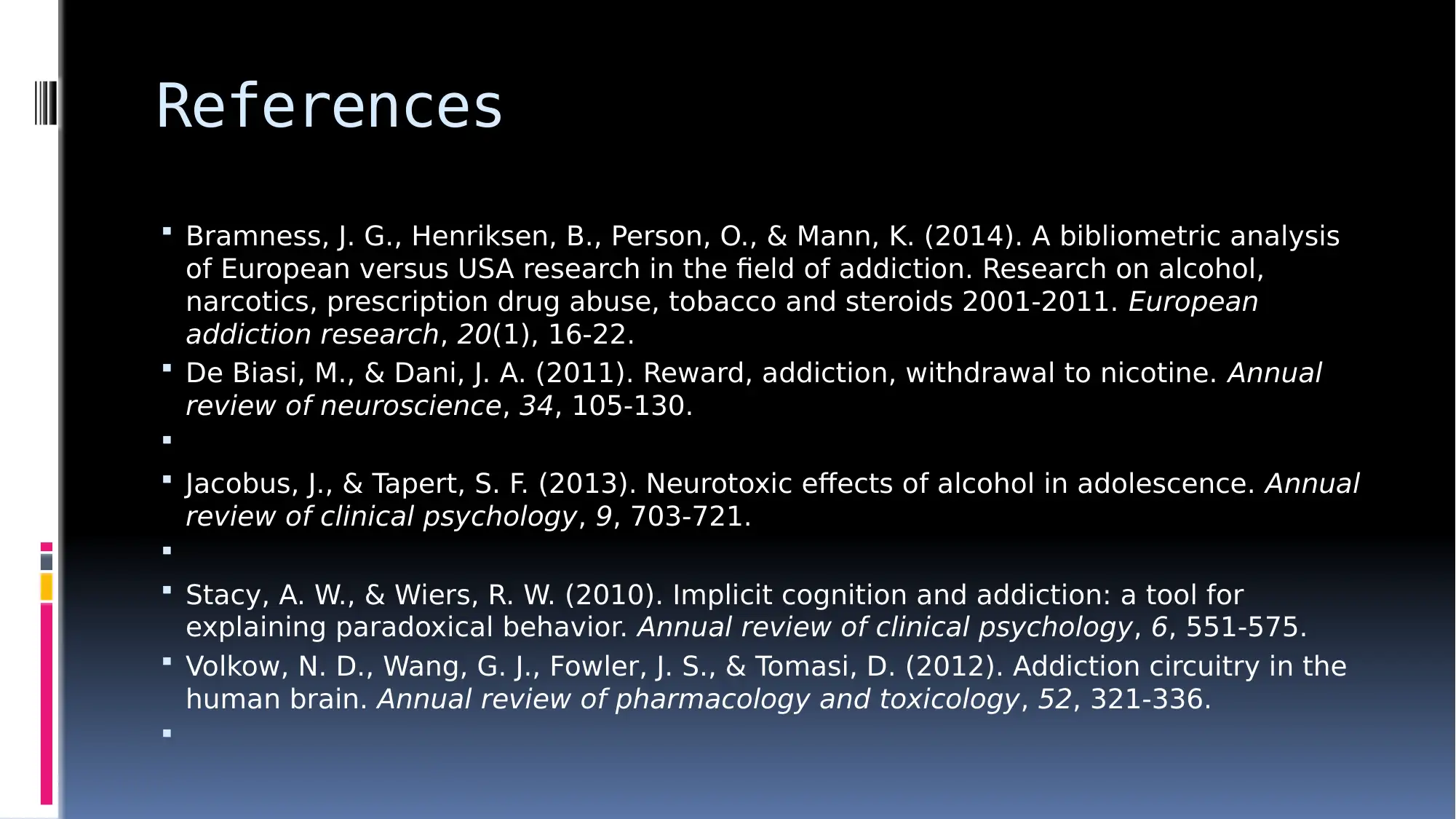
References
Bramness, J. G., Henriksen, B., Person, O., & Mann, K. (2014). A bibliometric analysis
of European versus USA research in the field of addiction. Research on alcohol,
narcotics, prescription drug abuse, tobacco and steroids 2001-2011. European
addiction research, 20(1), 16-22.
De Biasi, M., & Dani, J. A. (2011). Reward, addiction, withdrawal to nicotine. Annual
review of neuroscience, 34, 105-130.
Jacobus, J., & Tapert, S. F. (2013). Neurotoxic effects of alcohol in adolescence. Annual
review of clinical psychology, 9, 703-721.
Stacy, A. W., & Wiers, R. W. (2010). Implicit cognition and addiction: a tool for
explaining paradoxical behavior. Annual review of clinical psychology, 6, 551-575.
Volkow, N. D., Wang, G. J., Fowler, J. S., & Tomasi, D. (2012). Addiction circuitry in the
human brain. Annual review of pharmacology and toxicology, 52, 321-336.
Bramness, J. G., Henriksen, B., Person, O., & Mann, K. (2014). A bibliometric analysis
of European versus USA research in the field of addiction. Research on alcohol,
narcotics, prescription drug abuse, tobacco and steroids 2001-2011. European
addiction research, 20(1), 16-22.
De Biasi, M., & Dani, J. A. (2011). Reward, addiction, withdrawal to nicotine. Annual
review of neuroscience, 34, 105-130.
Jacobus, J., & Tapert, S. F. (2013). Neurotoxic effects of alcohol in adolescence. Annual
review of clinical psychology, 9, 703-721.
Stacy, A. W., & Wiers, R. W. (2010). Implicit cognition and addiction: a tool for
explaining paradoxical behavior. Annual review of clinical psychology, 6, 551-575.
Volkow, N. D., Wang, G. J., Fowler, J. S., & Tomasi, D. (2012). Addiction circuitry in the
human brain. Annual review of pharmacology and toxicology, 52, 321-336.
1 out of 22
Related Documents
Your All-in-One AI-Powered Toolkit for Academic Success.
+13062052269
info@desklib.com
Available 24*7 on WhatsApp / Email
![[object Object]](/_next/static/media/star-bottom.7253800d.svg)
Unlock your academic potential
© 2024 | Zucol Services PVT LTD | All rights reserved.





